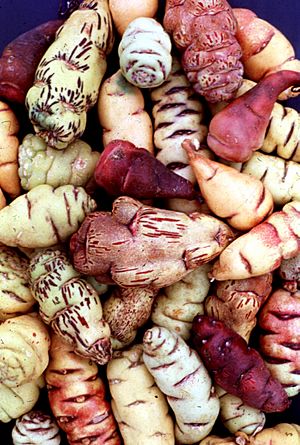Mashua facts for kids
Quick facts for kids Mashua |
|
|---|---|
 |
|
| Various mashua tubers of different shapes and pigmentations | |
| Scientific classification | |
| Genus: |
Tropaeolum
|
| Species: |
tuberosum
|
The mashua (scientific name: Tropaeolum tuberosum) is a type of flowering plant that grows in the Andes mountains. It is mostly found in countries like Peru, Bolivia, Ecuador, and parts of Colombia. People grow mashua for its tubers, which are like underground stems. These tubers can be cooked or roasted and eaten as a vegetable.
Mashua is a perennial plant, meaning it lives for more than two years. It is also a climber that can grow up to 2 to 4 meters (about 6.5 to 13 feet) tall. It is related to the garden nasturtium, which you might know as a pretty flower. Sometimes, mashua is grown just for its bright, colorful flowers.
Contents
Other Names for Mashua
While "mashua" is a common name in Peru and Ecuador, this plant has many other names depending on where you are.
Some of its other names include:
- Mashwa (Ecuador and Peru)
- Maswallo
- Mazuko
- Mascho (Peru)
- Añu (in Peru and Bolivia)
- Isaño
- Cubio (in Colombia)
- Tuberous nasturtium
In a region of Colombia called Boyacá, it is also known as Nabu.
Growing Mashua Plants
Mashua plants are very strong and can grow well even in poor soil. They also compete easily with weeds. This plant is perfect for farming in high mountain areas, where other crops might struggle.
Mashua plants can produce a lot of food. Farmers can get about 30 tonnes of mashua per hectare (about 2.5 acres) at an altitude of 3,000 meters (about 9,800 feet). Under special research conditions, they have even produced up to 70 tonnes per hectare!
One amazing thing about mashua is its natural protection against pests. It has special chemicals called isothiocyanates that keep insects, worms, and bacteria away. Even though mashua is grown by people, it can also survive in the wild because it grows so quickly and is very tough. In Colombia, farmers sometimes plant mashua next to potato fields. This helps to keep pests away from the potatoes.
Eating Mashua Tubers
When mashua tubers are raw, they can taste a bit bitter. This is because of chemicals called glucosinolates. But don't worry, the bitterness goes away after you cook them, freeze them, or even mash them up.
The tubers are a very important part of the mashua plant. They make up about 75 percent of the plant's dry weight when it's fully grown. For comparison, cereals usually only have about 40 percent of their dry matter in the edible part.
Some people might not like mashua because of its strong flavor. Also, there's an old story about mashua. A priest named Bernabé Cobo wrote in the 1500s that the Inca people used to give their soldiers large amounts of mashua. They believed it would make the soldiers less interested in their wives, so they would focus more on fighting.
However, mashua tubers roasted in traditional earthen ovens are considered a special treat. You can also shred raw mashua tubers into thin pieces and add them to salads. This gives the salad a spicy flavor and a nice crunchy texture.
Mashua as an Ornamental Plant
In the Andes, mashua is mainly grown for its edible tubers. But in other parts of the world with cooler climates, people grow it just for its beauty! It has a lovely trailing habit, meaning its stems hang down, and it produces showy, two-colored tubular flowers. These flowers usually appear in summer and autumn. The sepals (the outer parts of the flower) are orange-red, while the petals are bright yellow.
If you live in a place where it gets very cold and frosty in winter, mashua plants might need some protection to survive. One special type of mashua, called T. tuberosum var. lineamaculatum 'Ken Aslet', has even won an award called the Royal Horticultural Society's Award of Garden Merit. This award is given to plants that are excellent for gardening.
Images for kids
See also
 In Spanish: Cubio para niños
In Spanish: Cubio para niños



